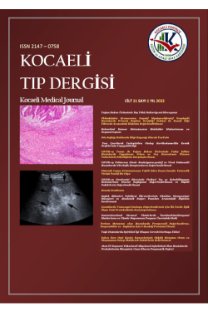Hemophilia Specific Quality of Life Index in Turkish Children and Young Adults. Cross-sectional Study from a Single Center
___
- 1. Barco S, Woersching AL, Spyropoulos AC, Piovella F, Mahan CE. European Union-28: an annualised cost-of-illness model for venous thromboembolism. Thromb Haemost. 2016;115:800e8.
- 2. Heit JA, Ashrani A, Crusan DJ, McBane RD, Petterson TM, Bailey KR. Reasons for the persistent incidence of venous thromboembolism. Thromb Haemost. 2017;117:390e400.
- 3. January CT, Wann LS, Alpert JS, Calkins H, Cigarroa JE, Cleveland JC Jr, et. al. American College of Cardiology/American Heart Association Task Force on Practice Guidelines. 2014 AHA/ACC/HRS guideline for the management of patients with atrial fibrillation: a report of the American College of Cardiology/American Heart Association Task Force on Practice Guidelines and the Heart Rhythm Society. J Am Coll Cardiol. 2014 Dec 2;64(21):e1-76. doi: 10.1016/j.jacc.2014.03.022. Epub 2014 Mar 28. Erratum in: J Am Coll Cardiol. 2014 Dec 2;64(21):2305-7. PMID: 24685669.
- 4. Çelik A, İzci1 S, Kobat M A, Ateş H A, Çakmak A, Çakıllı Y, Yılmaz M B. The awareness, efficacy, safety, and time in therapeutic rangeof warfarin in the Turkish population: WARFARIN-TR Anatol J Cardiol. 2016; 16: 595-600.
- 5. Kearon C, Akl EA, Comerota AJ, Prandoni P, Bounameaux H, Goldhaber SZ, et al. Antithrombotic therapy for VTE disease: antithrombotic therapy and prevention of thrombosis, 9th ed: American College of Chest Physicians Evidence-Based Clinical Practice Guidelines. Chest. 2012;141. e419Se96S.
- 6. Kakkos SK, Gohel M, Baekgaard N, Bauersachs R, Bellmunt-Montoya S, Black SA, et. al. Editor's Choice - European Society for Vascular Surgery (ESVS) 2021 Clinical Practice Guidelines on the Management of Venous Thrombosis. Eur J Vasc Endovasc Surg. 2021 Jan;61(1):9-82. doi: 10.1016/j.ejvs.2020.09.023. Epub 2020 Dec 15. PMID: 33334670. ed 2020; 8(3):220-22.
- ISSN: 2147-0758
- Yayın Aralığı: 3
- Başlangıç: 2012
- Yayıncı: -
Adnan DENİZ, Nazan SARPER, Emine ZENGİN, Sema AYLAN GELEN
COVID-19 Dalgaları Arasında Kalp Damar Cerrahisi Hastalarının Başvuru Şeklindeki Değişiklikler
Tülay ÇARDAKÖZÜ, Zeki TALAS, Ali Ahmet Arıkan, Oğuz Omay, Burhan Küçük, Muhip KANKO, Sadan YAVUZ, Uğur POSTAL
Nazal polipozis’e eşlik eden IL5 (-746), IL6 (-174) ve IL18 (-607) gen polimorfizimleri
Mahmut Huntürk ATİLLA, SİBEL ÖZDAŞ, Sibel BAŞTİMUR, Talih ÖZDAŞ, Sami Engin MUZ, Isilay OZ, İpek Canatar İpek CANATAR
El ve Üst Ekstremite Cerrahisi Ameliyatlarında Kullanılan İmplantlar Ne Zaman Çıkarılmalı?
Lumbosakral Bölgenin Subkutan Dokusunda Benign Granüler Hücreli Tümör: Olgu Sunumu
Can ilker Demir, Çiğdem Vural, Umay Kiraz, Esra Civriz
Ayşegül Barak Özer, Mehmet Baltacıoğlu, Şima Ceren Pak, Çiçek Hocaoğlu
Yaşlılarda Enerji Cihazları İle Yapılan Total Tiroidektomi Sonuçları
Murat Burç Yazıcıoğlu, Abdullah Güneş
Ferit Onur Mutluer, Volkan Çamkıran, Nilüfer Çetiner, Alpay Çeliker
Subklinik Hipotiroidide Kolesterol Düzeyleri ve Levotiroksin Tedavisinin Kolesterol Düzeyleri Etkisi
Hasan Ali ALTUNBAŞ, Mustafa KAPLAN, Ömer Öztürk, İlyas Tenlik
Neonatal Gastrik Perforasyon: 2002'den 2015'e Tek Merkezde Bir Deneyim
Fatih KILIÇBAY, AYLA GÜNLEMEZ, Ayşe ENGİN ARISOY, Mustafa Alper AKAY
